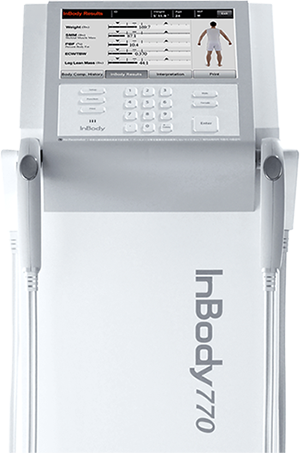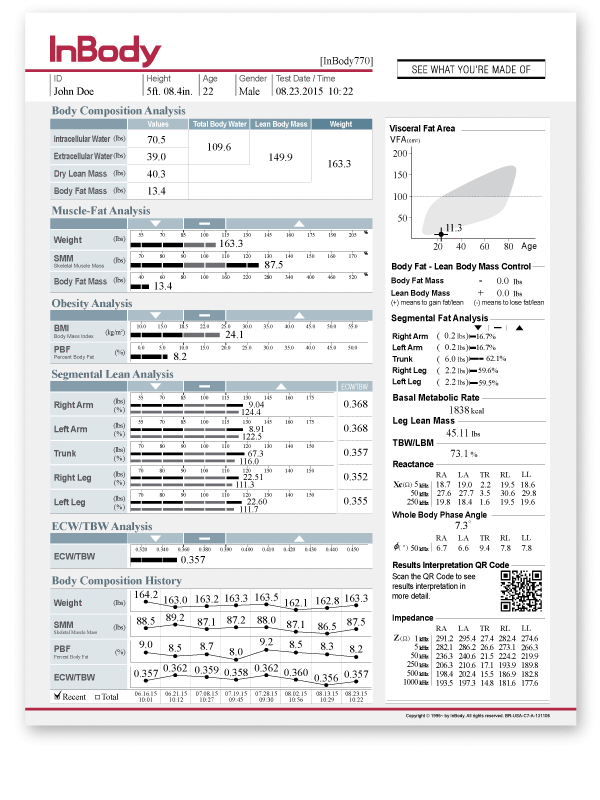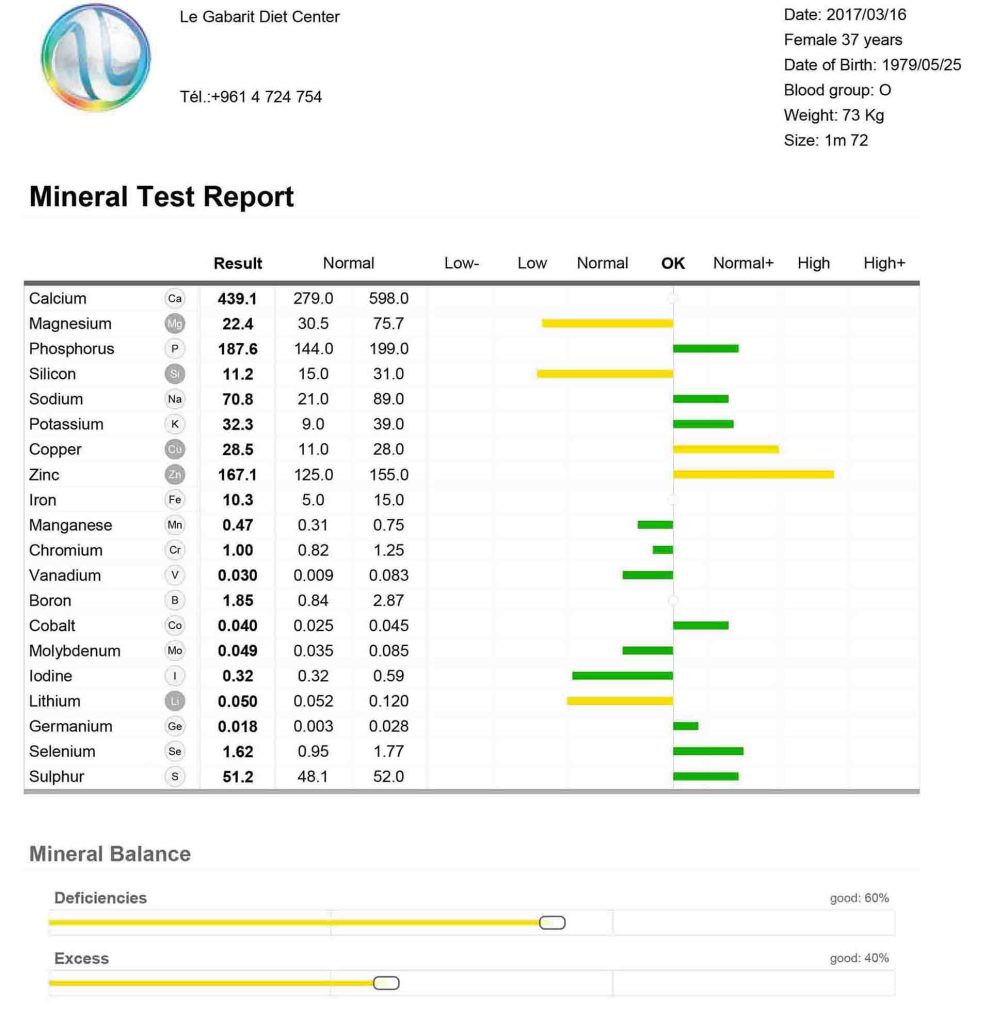Tests
The inbody test provides a comprehensive view of body composition balance.
Body water, proteins, minerals, and body fat, which are the components of the human body closely relate to the status of our health. Using the method of quantitative analysis, these elements of the body composition and body composition analysis provide basic information required for assessing the status of the body.

Result Sample

Food Intolerance
What is a Food Intolerance?
Food intolerance (also known as food sensitivity) can result from your body reacting adversely to certain foods. Often the foods we include regularly in our diet or the foods we crave may be the ones causing the problem. Food intolerance symptoms may be due to several factors – an enzyme deficiency, for example in lactose intolerance; sensitivity to certain chemicals, for example amines in chocolate and red wine can cause migraines; or an IgG immune response as indicated by your test results.
Research has shown that food intolerance can be linked to IgG antibodies raised by your immune system when you eat certain foods1. Under normal circumstances these antibodies form complexes with proteins in the food. These complexes are then eliminated by your immune system without any ill-effects. If the immune or digestive systems are compromised, these complexes may be deposited around the body causing inflammation and can result in a wide range of symptoms such as fatigue, IBS, bloating, migraine or obesity. So your body sees the food as a “problem” food.
Symptoms can last for several days or longer and are often intermittent, making it difficult to identify which foods your body is struggling to deal with. Food intolerance should not be confused with food allergy.
Testing for Food Intolerance
By taking a small, finger-prick blood sample, it is possible to measure food-specific IgG antibodies in your blood. Your IgG antibody readings are shown in your personal Food Intolerance Test results.

Interpreting your
Test Results
You have been tested against all of the foods listed in your report. As you can see, each food is listed in the red, yellow or green column. Each colour indicates the strength of your body’s immune reaction to each food.
If you are experiencing adverse symptoms and your test is showing raised IgG antibodies to certain foods, this may indicate an intolerance to these foods. Removing them from your diet for at least 3 months may result in an improvement of symptoms. After this time it should be possible to reintroduce foods slowly back into your diet without suffering further symptoms.
Your Food Intolerance Test results are shown as ELEVATED, BORDERLINE or NORMAL and the concentration of IgG antibodies (in U/ml) is shown in brackets after each food.
The following will guide you through your dietary changes:
ELEVATED
Indicates a strong antibody reaction to that particular food.
You should eliminate these foods for at least 3 months. Substitute other foods listed in the NORMAL column and the relevant food section. For example, if your test indicates you are intolerant to wheat then cut out wheat and replace with a variety of oats, rye bread, quinoa and brown rice (as long as none of these are in the ELEVATED column) to ensure you are still obtaining a wide variety of nutrients in your diet.
NB If there are no foods in the ELEVATED column, then the BORDERLINE foods should be avoided for 3 months
BORDERLINE
Indicates a lower antibody reaction to that particular food.
You should reduce and rotate these foods for at least 3 months to avoid an increase in intolerance.
To rotate foods, you need to eat them no more than once every 4 days. For example, to rotate wheat, you could have wheat bread on day 1; oat cakes on day 2; corn bread on day 3; rye bread on day 4; durum wheat pasta on day 5 etc. Choose alternative foods from the green NORMAL column and the relevant food section (found in Planning your Diet). Ensure these foods are not listed in the ELEVATED column.
NORMAL
Indicates no significant reaction to that particular food.
These foods can be eaten without restriction, unless you already know of specific foods that have previously caused a reaction. In such cases, you should continue to avoid them as this reaction could be due to a nonimmune mechanism.
Oligo Scan
The revolutionary method to detect directly the bioavailability of trace elements and heavy metals intoxications.
The OligoScan technology allows you to make a quick and precise analysis of the trace elements and heavy metals in the tissues of your patients. The measurement is made directly in your office with a portable spectrophotometer device approved by OligoScan.
The collected data from your patient is sent to the secure central Oligoscan server within a few clicks. And within 20 seconds, you get the results back.This test is a revolutionary technique to check the mineral status of your patients in real time. For a health care provider, it allows you to know the most efficient supplementation that would maximize the nutritional benefits for your patients.
In case of heavy metal toxicity, you can prescribe chelating techniques, supplements and/or lifestyle changes. Even more importantly, efficient mobilization is easily discernible with the Oligoscan and our upcoming clinician videos will explain all the details.
OligoScan is the most innovative testing methodology with the fastest turn around of results available anywhere in the world. The technology is an invaluable screening tool for actual tissue levels of minerals as opposed to other testing which is only indicative of what is being pulled out of that particular vector. Together with the urine, fecal, hair and blood measurements, the Oligoscan result transforms the information you have analogous to a 2 dimensional picture and turns it into a 3 dimensional holographic projection within which you can now practically interact.
The data is invaluable and makes for a very precious prevention tool allowing for a longitudinal follow-up of your patients’ mineral status, key mineral ratios, heavy metal levels, mobilization of those metals and overall oxidative stress.

- Hair Fall and Broken Nails
- Fatigue
- Flatulence / Bolus / Indigestion
- Hormonal Imbalance
- Emotional Problems
- Cardiovascular Diseases
- Stress
- Low Skin Healing
- Impaired Cognitive Functions
- Aging and Wrinkle Ability
- Slow Metabolism
- Overweight and Nutritional Balance
- Osteoporpsis
Result Sample

GI Map Test
What is GI-MAP Testing and what can it do for me?
Gastrointestinal Microbial Assay Plus (GI-MAP™) is a complete screening for your digestive tract that can help determine the presence of digestive problems such as Leaky gut, IBD, IBS, etc.
SIBO Test
What is the SIBO test?
SIBO test is a non-invasive breath test which captures exhaled hydrogen (H2) and methane (CH4) gases following patient ingestion of a lactulose solution to evaluate bacterial overgrowth of the small intestine.
Candida Test
Candida is a type of yeast (a fungus) that is normally found in the human microbiome, but too much of it can cause an infection.
This infection can be diagnosed by a Blood culture or a Stool test
Personal genetic analysis
based on an overview of your DNA
Personal genetic analysis gives appropriate recommendations in the field of early prevention and appropriate action, to reduce the risk of developing a disease. This is especially important for those of us who are more exposed because of our genetic makeup.

Diseases
The whole plan of our organism is encoded in our genes. The genes determine the structure and the functioning of our body. If we inherit a significant error in the genetic code, then we will develop a genetic disorder. Discovering such genetic flaws is what doctors nowadays do. Our tendencies for developing many diseases are also encoded in our genes
Traits and talents
